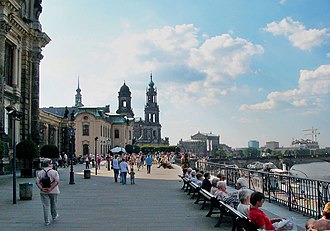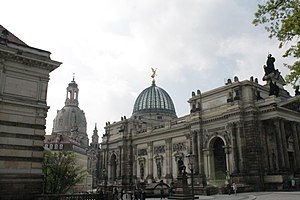Brühl's Terrace


Brühl's Terrace(German:Brühlsche Terrasse) is a historic architectural ensemble inDresden,Germany.Nicknamed "The Balcony of Europe", the terrace stretches high above the bank of the riverElbe,and is located north of the recently rebuiltNeumarktSquare and theFrauenkirche.
History and character
[edit]The present-day terrace was part of the city's fortifications, rebuilt upon the 1546/47Schmalkaldic Warat the behest of ElectorMaurice of Saxonyand his successorsAugustusandChristian.The name Brühl's Terrace is a reference to CountHeinrich von Brühl,Minister of ElectorFrederick Augustus II,who from 1737 had a city palace with a gallery, a library and adjacent gardens built on the location. In 1747 the whole terrace was given to him by the Saxon elector as a gift for the innovative introduction of a betterment tax.

After the Saxon defeat at theBattle of Leipzigand the occupation byRussiantroops, military governorPrince Nikolai Grigorjevich Repnin-Volkonskiordered the opening to the public in 1814. He charged the architectGottlob Friedrich Thormeyerwith the building of a flight of stairs at the western end to reach the terrace fromCastleSquare andAugustus Bridge.The Brühl Palace was demolished in the course of the building of the SaxonStändehausin 1900.


The ensemble was totally destroyed in February 1945 when the city was heavily hit by the AlliedBombing of Dresdenduring the end phase ofWorld War II.Today, it has been rebuilt; the precise amount restored is difficult to say as a percentage, but in general one can say the ensemble looks very much the same today as it did in the past.
Today, Brühl's Terrace is again one of the main city landmarks besides the Frauenkirche (Church of our Lady),Dresden Castle,theHofkircheand buildings on Theatre Square such as theZwingerand theSemperoper,which are all located in the vicinity. At theBärenzwingerstudents' club near the monument forJohann Friedrich Böttger,one can see a fingerprint in a guard rail of the terrace garden. This dactylogram is said to be proof of the strength ofAugustus the Strong,who is said to have left the mark - but is only one of many myths surrounding August, such as the legend that he fathered 365 children.
Architectural parts of the terrace
[edit]Most people enter the terrace from the Schlossplatz (Castle Square) on the west end of the terrace. BesidesSaxony'sSupreme Courta staircase with four sculptures (The Four Times of Day) leads from the Schlossplatz (Castle Square) up to Brühl's Terrace. One of the next buildings to the right is the Academy of Fine Arts. There is an ensemble of important buildings, such as theAlbertinum.
- Sächsisches StändehausbyPaul Wallot
- Sekundogenitur
- Academy of Fine Arts
- Jungfernbastei(Belvederehügel)
- Moritzmonument
- Bärenzwingerbasement vault
- Hofgärtnerhaus
- Albertinum
- Delphinbrunnen
- Staircase byGottlob Friedrich Thormeyer
Statues of Note
[edit]- Ludwig Richter
- Ernst RietschelbyJohannes Schilling
- Gottfried SemperbyJohannes Schilling
- Johann Friedrich Böttger
- The "Four Times of the Day" group (Vier Tageszeiten) byJohannes Schilling
The balconies of Europe and of Dresden
[edit]Brühl's Terrace is known as the "Balcony of Europe", a name which was first thought up and used at the beginning of the 19th century and which since then has been used in all kinds of literature.
The name "Balcony of Dresden", on the other hand, is more regionally used for a tower six kilometers further to the East on a slope by theElbeinLoschwitz,an area known for expensive living.

